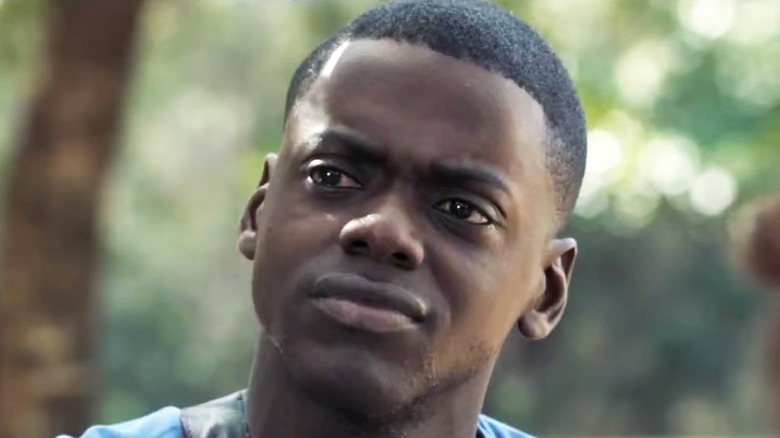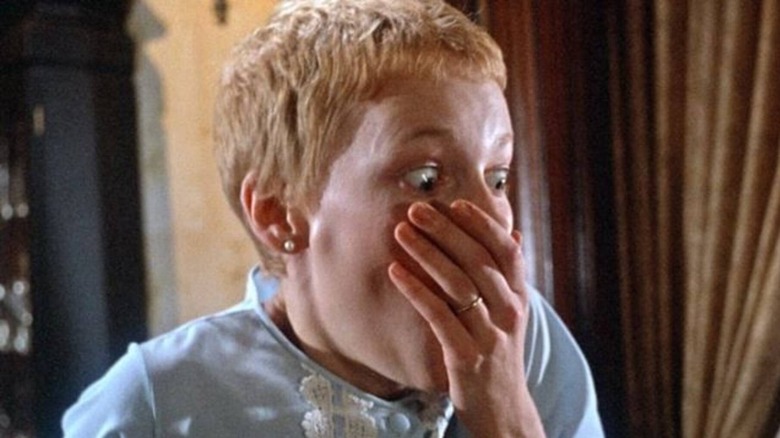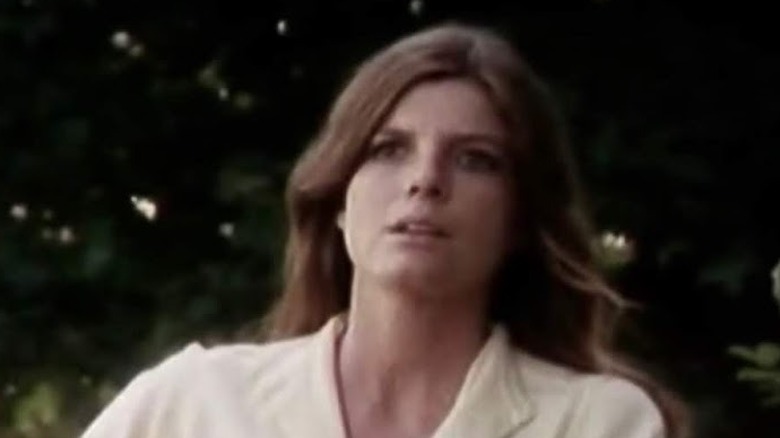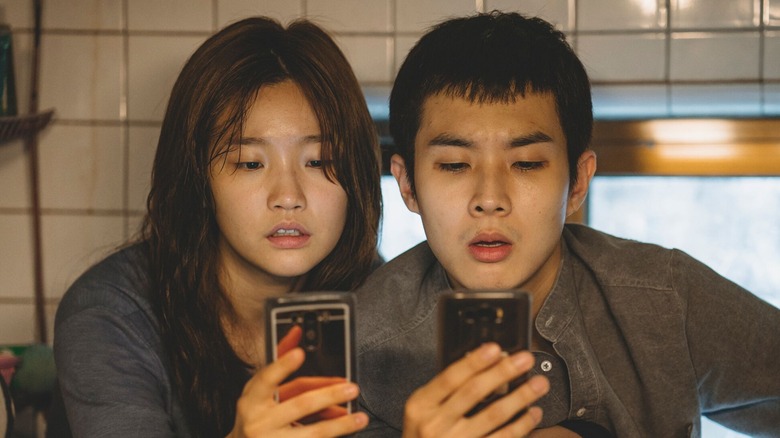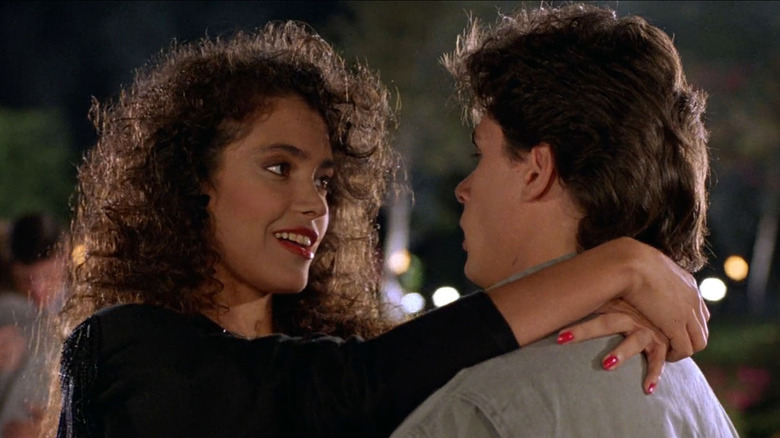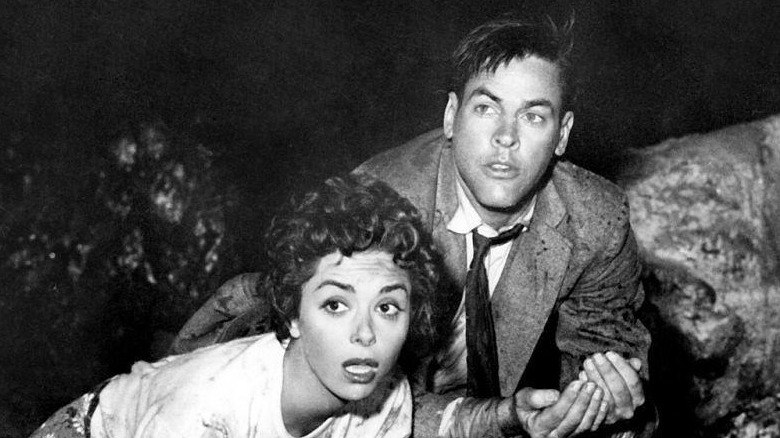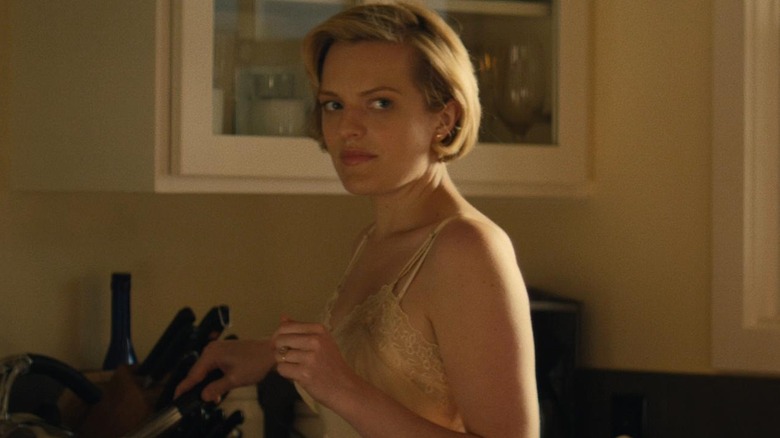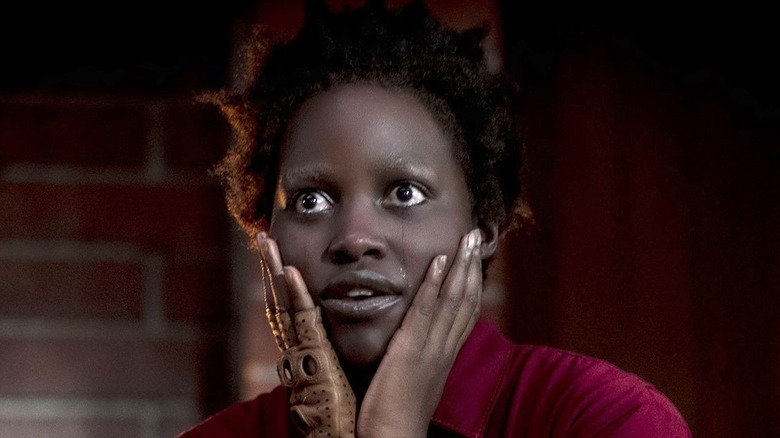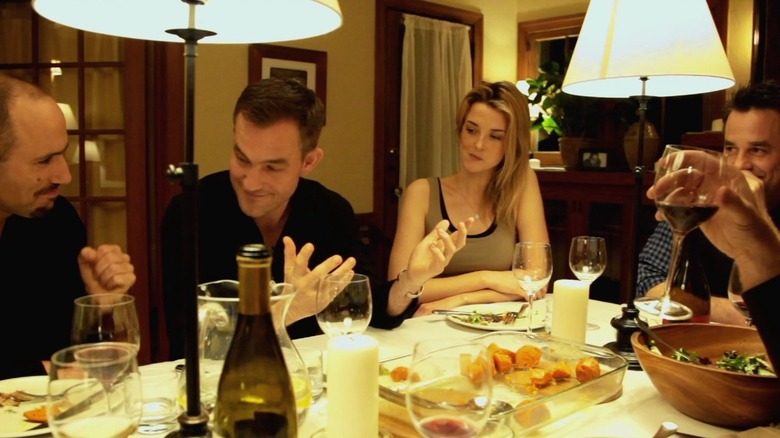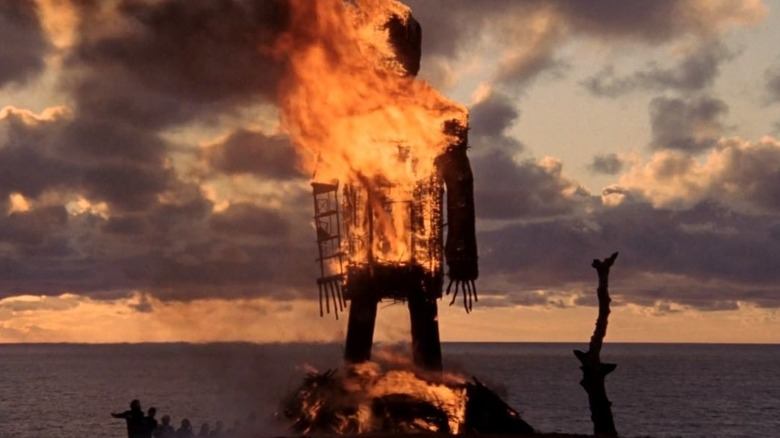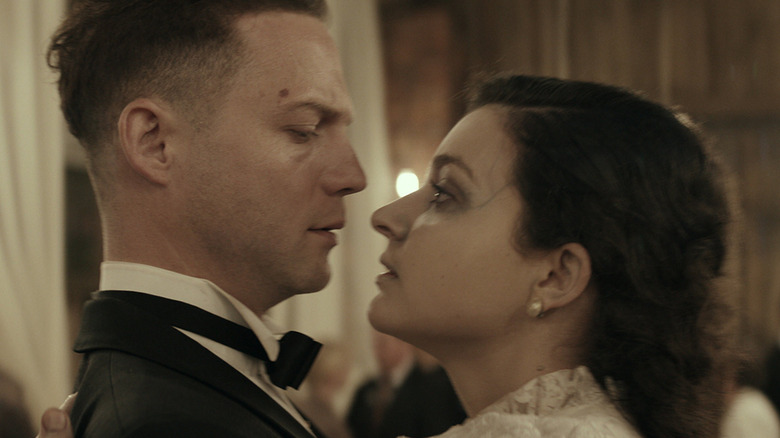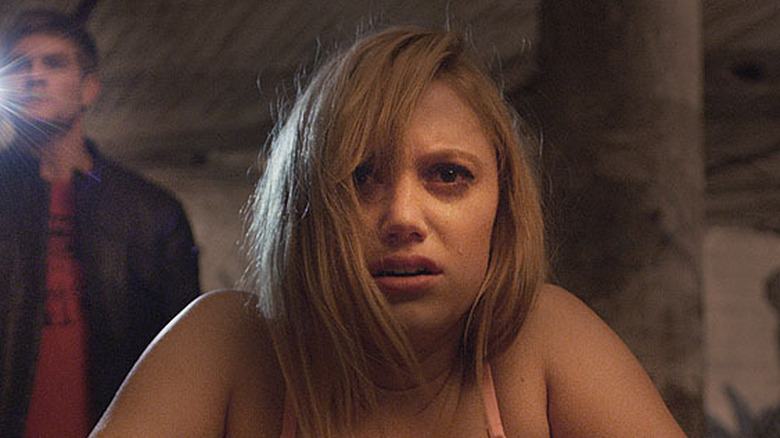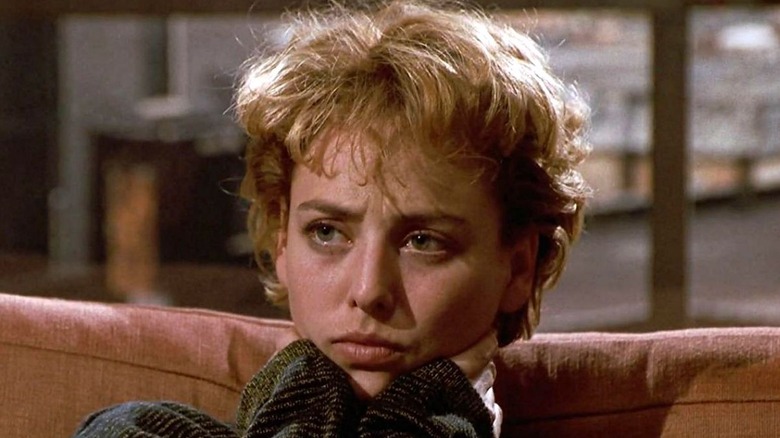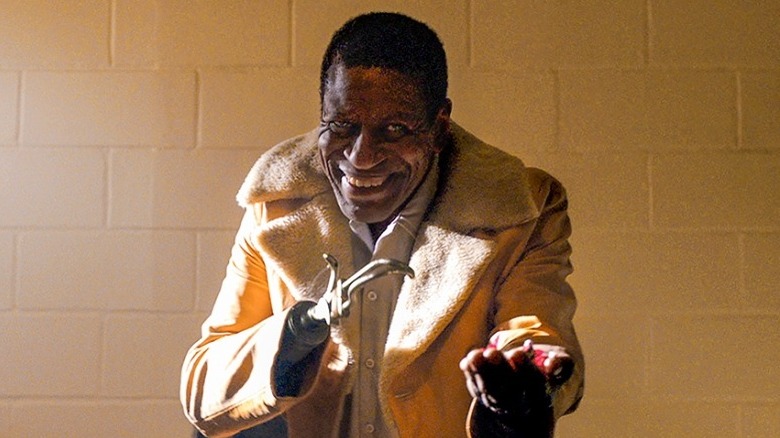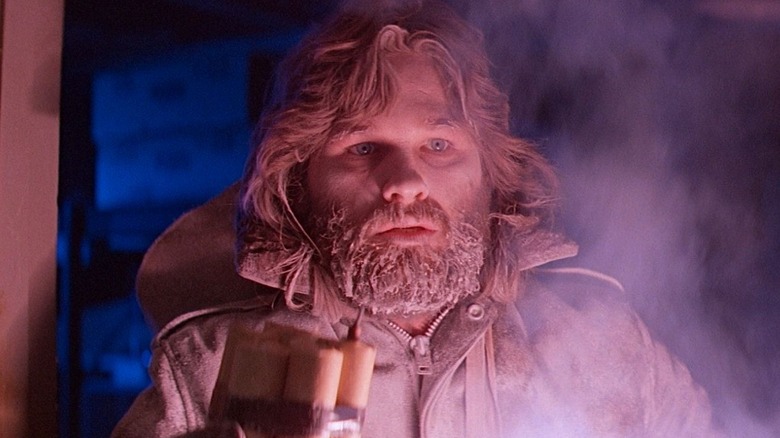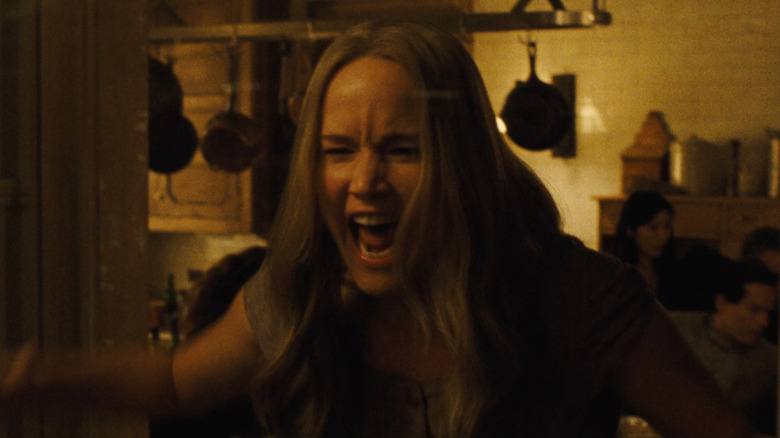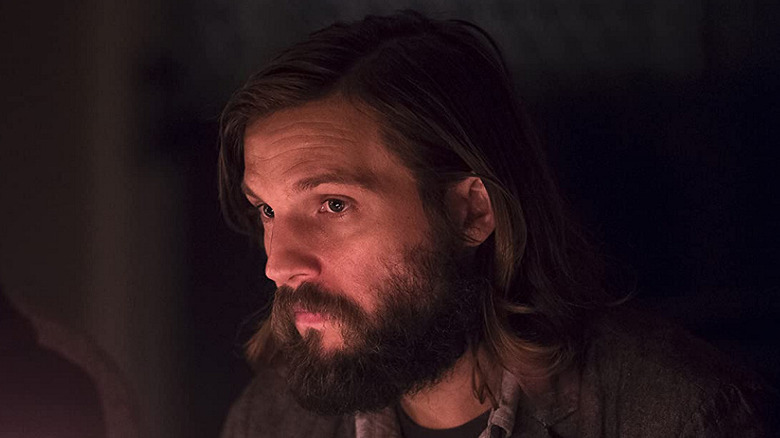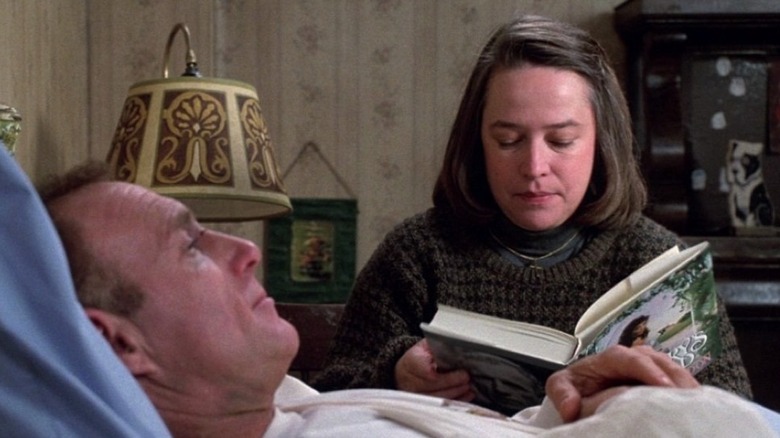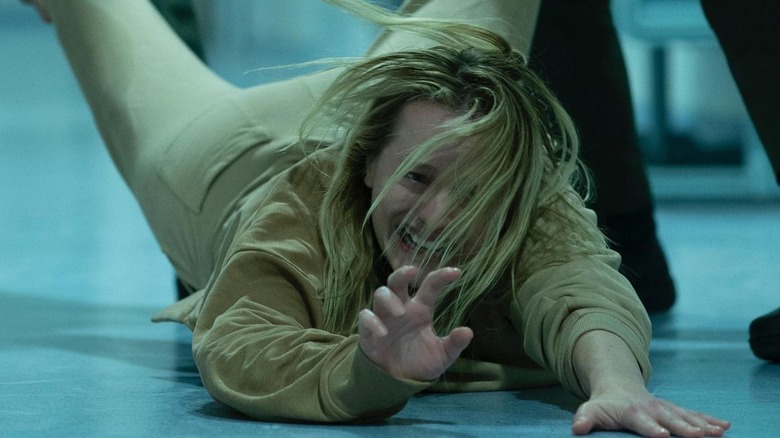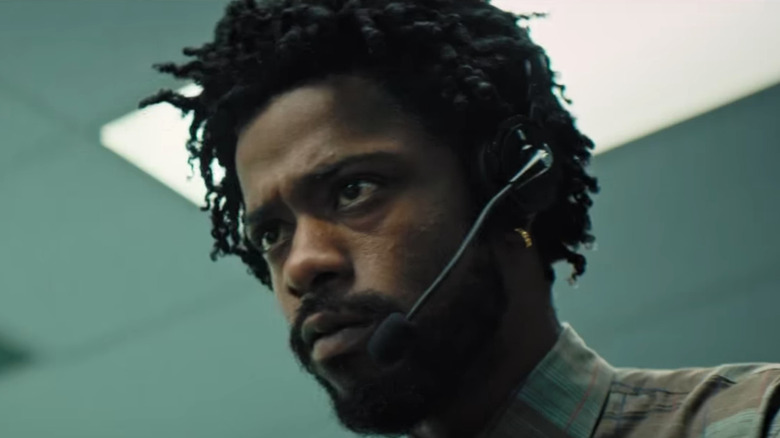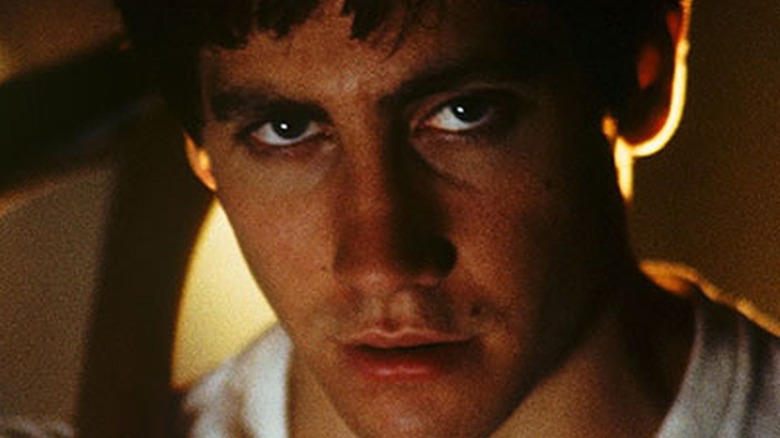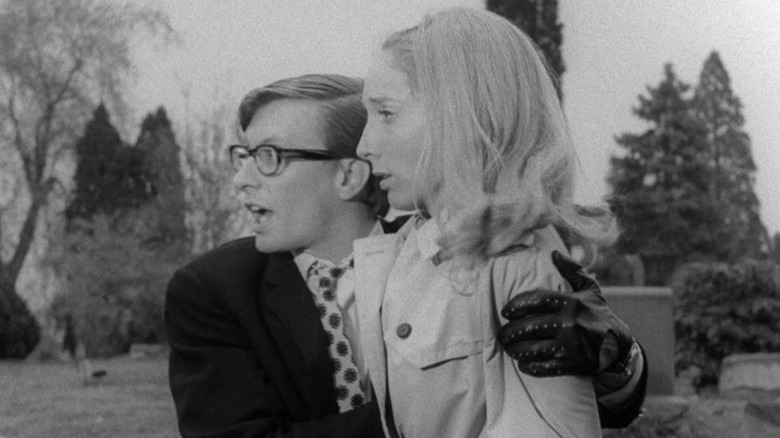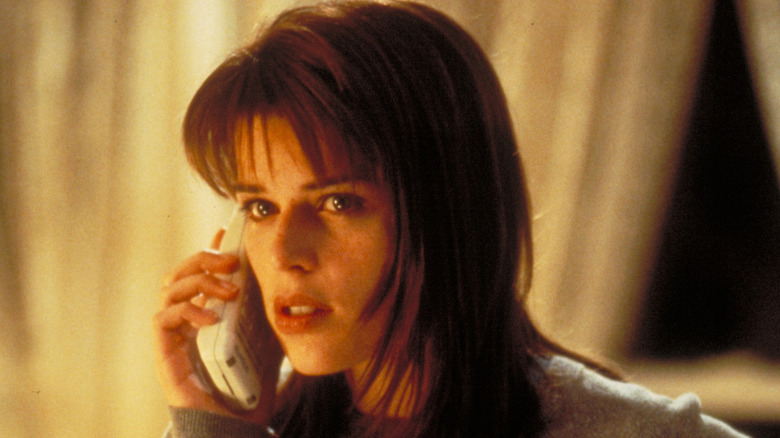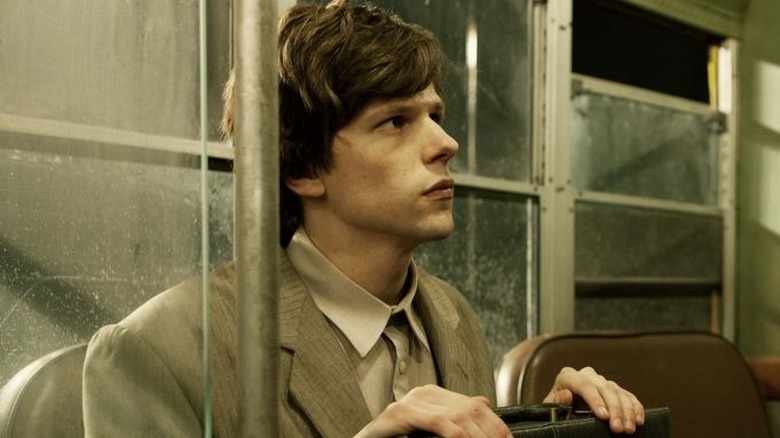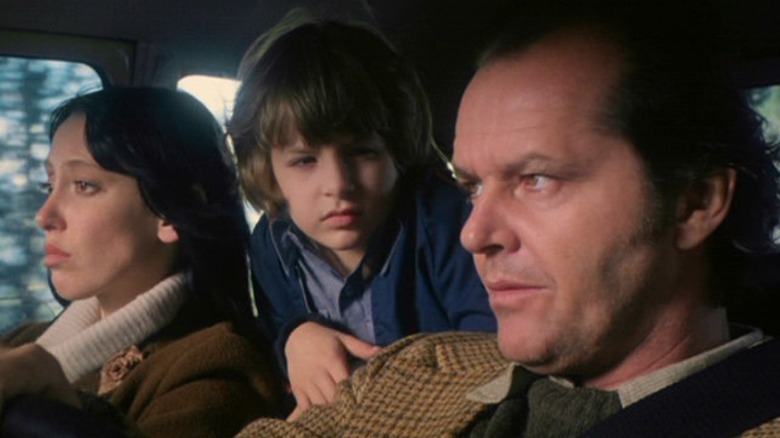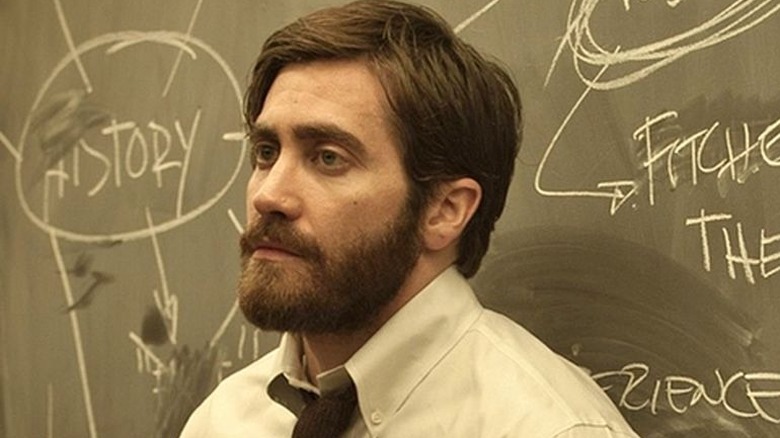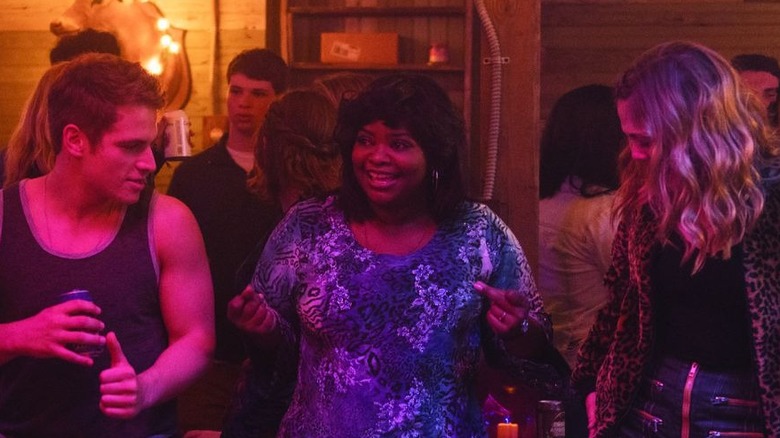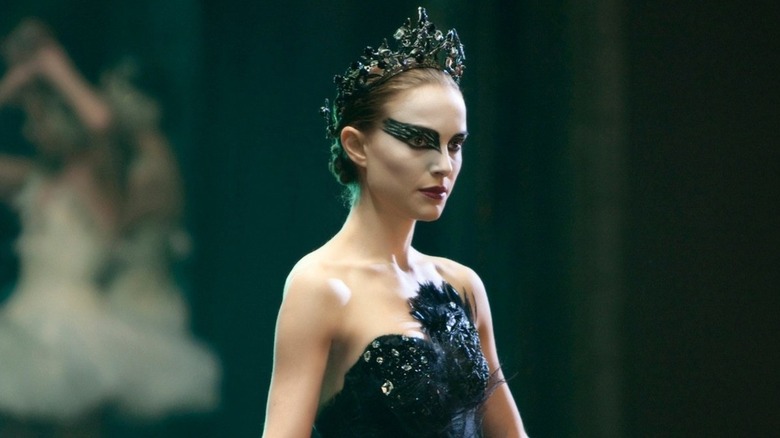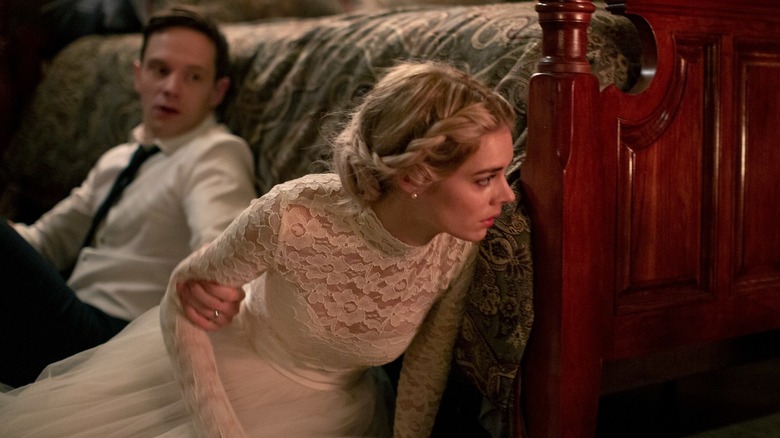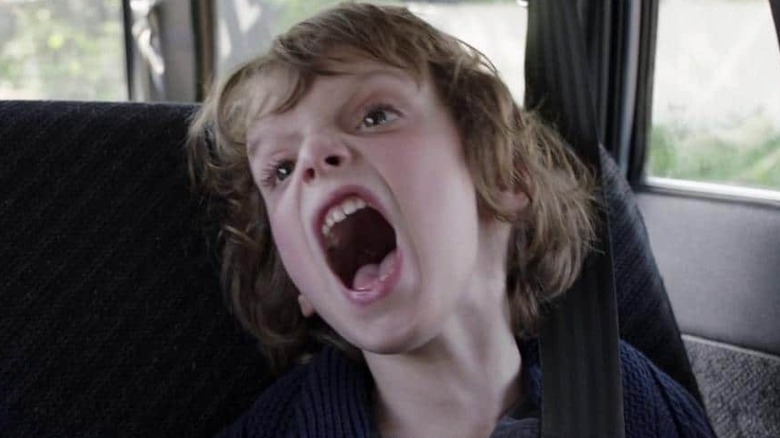30 Scary Movies Like Get Out You Need To Watch
Jordan Peele's award-winning directorial debut "Get Out" became an instant classic upon its release for its unflinching commentary on race and class and its "stinging satirical wit" (via Rolling Stone). Not only is this tour de force of horror a hard-hitting, racially charged social thriller, it's also an intense psychological ride. Peele's masterful foray into horror boasts an extraordinary critic rating on Rotten Tomatoes, with the consensus that it's "funny, scary, and thought-provoking" and it "seamlessly weaves its trenchant social critiques into a brilliantly effective and entertaining horror/comedy thrill."
Ultimately, the beauty of this film is that it can be successfully and effectively viewed through the lens of a variety of horror subgenres because it has so many layers and so much to say. With this in mind, we've compiled a list of 30 scary movies similar to "Get Out" that you need to watch. Below, you'll find psychological and social thrillers (particularly ones that feature a lot of gaslighting), relationship-focused horror, smart horror-comedies, dark satires, socially conscious horror, folk horror, and films about body snatchers and doppelgängers. All are worth watching if you're a fan of Jordan Peele's brand of horror.
Rosemary's Baby (1968)
Roman Polanski's social thriller masterpiece "Rosemary's Baby" has influenced a great number of modern horror movie filmmakers, including Jordan Peele, who's talked at length about the impact this film had on "Get Out." Based on Ira Levin's novel of the same name, the film begins with New York couple Rosemary (Mia Farrow) and Guy (John Cassavetes) Woodhouse moving into their new home in the Bramford, a Renaissance Revival apartment building with a pretty terrible history. According to Rosemary's friend Hutch, that past is full of gory stories about murder, witchcraft, and Satanic worship. But those warnings can't stop them from signing the lease: For Rosemary, this marks the perfect chance to settle down and grow their family, though struggling actor Guy's much more concerned with growing his career, at least until they have dinner with their older neighbors, Minnie and Roman Castevet. After that, Guy's more than happy to indulge Rosemary's desire for a baby. When she does conceive, Rosemary's happiness is brief and fleeting; an awful pain soon takes root inside her. Even worse, Guy and her neighbors start controlling every aspect of her pregnancy — and her life: the books she reads, the people she talks to, the food she eats, even the doctor she sees.
Like "Get Out," "Rosemary's Baby" delivers clear social messages — specifically about the evils people will commit in exchange for wealth, power, and their deepest desires, as well as the way patriarchal oppression strips women of their bodily autonomy.
The Stepford Wives (1975)
In several interviews, including one with Criterion, Jordan Peele has discussed the influence Bryan Forbes' 1975 social thriller — and the 1972 Ira Levin novel it's adapted from — had on him. The connections between "Get Out" and "The Stepford Wives" are both overt and subtle. For one, respective leads Chris and Joanna are both photographers. They both travel from the city to an isolated community for their significant others — Chris to the Armitage estate for Rose, and Joanna to the creepy suburbs of Stepford for husband Walter. Both have friends who provide welcome comic relief amid rising tensions, and both are disturbed by the bizarre behavior of others around them while they try to cope with feeling out of place. More than that, both are manipulated and gaslit by people they love and who they think love them. The main difference is that each film depicts a separate — but not completely dissimilar if we take intersectionality into account — social issue. While "Get Out" examines racial power dynamics, "Stepford Wives" examines gender power dynamics. The other notable difference? Forbes' film concludes on a much darker note. Peele almost matched it with his alternate ending, but eventually decided to offer a more hopeful close. We're glad he did.
Ultimately, Peele strikes a better balance between the horrifying, the comedic, and the issues at hand, but "Stepford Wives" provides a great blueprint for how he got there.
Parasite (2019)
Bong Joon Ho's "Parasite" has an incredibly long list of accolades, and in 2020, it became the first non-English movie to win Best Picture at the Academy Awards. The film follows the struggling Kim family, who dwell in a semi-basement apartment and work odd, temporary jobs while attempting to claw their way out of poverty. When Ki-woo's friend, university student Min-hyuk, reveals that he's leaving to study abroad and offers Ki-woo the opportunity to replace him as an English tutor for the daughter of the well-off Parks, Ki-woo and the rest of his family see a golden chance to start climbing up that social ladder. Soon enough, the Kims manage to integrate themselves into the lives of their rich employers by finding ways to push out the others who work for the Parks. Like "Get Out," this South Korean social thriller concerns itself with ever-expanding class divides. It also touches on the kind of distrust and discomfort that comes with fearing one's neighbor, another culturally relevant issue that speaks to the tumultuous relationship between South Korea and North Korea.
All in all, Bong expertly weaves humor, drama, and horror throughout his award-winning film, using them to examine how class systems dehumanize people, widen the rift between rich and poor, and condemn working class families to continual suffering. His dark satire also unveils a hard truth about the barriers built between the wealthy and lower class workers: they're nearly impossible to overcome. Even trying can cost you your life.
Society (1989)
Brian Yuzna's "Society" makes the list for scary movies like "Get Out" you need to watch because it features a ton of gaslighting and a good, healthy dose of horror-comedy. The narrative follows Bill Whitney (Billy Warlock), who lives with his wealthy parents and older sister in a Beverly Hills mansion. We immediately see that there's quite a bit of tension between Bill and his upper-crust parents. He feels like he's too different from them, and he really doesn't trust their high-society friends and lifestyle. In fact, all told, he's pretty sure he's adopted. At the start of the film, Bill is working on overcoming those negative internal thoughts and improving his shaky parent-son relationships with help from his therapist. But after a strange encounter with his sister's ex-boyfriend, who claims the rest of his family engage in horrendous acts, Bill starts to believe that his concerns may not be as unwarranted as everyone around him would have him believe. In fact, the true villains of this story are even more bizarre and horrifying than he could have ever imagined. Ultimately, "Society" serves as another scathing critique of high society, but it's also an engaging exploration of an adoptee's deep-set fear of not truly belonging.
Invasion of the Body Snatchers (1956)
With its political allegories and blending of sci-fi and horror, the black-and-white, Kevin McCarthy-led "Invasion of the Body Snatchers," based on Jack Finney's 1954 novel of the same name, helped set the stage for all the body snatcher movies we know and love today, including "Get Out." The story follows Dr. Miles Bennell (McCarthy) and his ex-girlfriend Becky Driscoll (Dana Wynter) as they try to make sense of what one psychiatrist calls an "epidemic of mass hysteria" after a growing number of patients begin suffering from Capgras syndrome. Basically, these people have convinced themselves that their loved ones aren't their loved ones anymore, and that they've been replaced by imposters.
Our heroes soon discover the unfortunate truth behind these complaints and, as the body snatchers work to replace humans with pod-grown doppelgängers, must find a way to save themselves and warn other towns of the danger. Director Philip Kaufman, a great fan of this 1956 film, produced a very well-received remake of "Invasion of the Body Snatchers" in 1978 that features quite a cast: Donald Sutherland, Jeff Goldblum, Leonard Nimoy (who we know best as Spock) — and even a cameo from McCarthy himself. Really, both versions of this story are worth a watch.
The One I Love (2014)
For those who have a taste for horror but a moderate-to-significant aversion to most gore, "The One I Love" offers an intimate, slow-growing kind of terror that's certain to unnerve you — and perfect for date night. In this domestic thriller, a therapist (Ted Danson) convinces married couple Sophie (Elisabeth Moss) and Ethan (Mark Duplass) to spend a weekend retreat at a large estate as a way to try to save their relationship and mend the disconnect between them. Once there, the situation becomes uncomfortably complicated. Like, doppelgänger complicated.
As most films about confrontations with other selves do, this movie elicits a steady feeling of disquiet. Ethan and Sophie are forced to confront themselves, the people they married, and the people they want to love. While the film starts out as a humorous romantic drama, it slowly shifts to surreal psychological horror wherein the characters unwittingly gaslight each other. And as the mystery of their other selves unravels, so does their relationship. Even worse, it may not be salvageable. With a few twists and turns, this quiet horror about a crumbling marriage and a terrifying side of love will leave you unsettled but satisfied.
Us (2019)
"Us," Jordan Peele's second venture into feature-length horror, has enjoyed tremendous critical acclaim. The film begins at a boardwalk carnival in 1986, where we see a little girl named Adelaide enter a creepy funhouse only to find a doppelgänger of herself. Flash forward a couple of decades, and we meet grown-up Addy, who — given her experience in the house of mirrors as a child — isn't super enthused about a beach vacation in Santa Cruz with her husband and kids. She agrees to it anyway, but it turns out she was right to dread the trip: Soon, she and her family — along with everyone else in the country — are confronted by violent, feral doppelgängers called "The Tethered," adorned in red jumpsuits and hell-bent on destroying their doubles. Addy's faced with trying to keep her family safe and alive while also protecting a dark secret from all those years ago.
Coherence (2013)
James Ward Byrkit offers another head-spinning doppelgänger movie with his directorial debut "Coherence," whose ensemble cast includes Nicholas Brendon (Xander of "Buffy the Vampire Slayer" fame). The ambitious Byrkit constructed this unique movie by filming in his own home without a crew or a script. The actors were given basic outlines to follow for their characters and motivations — and to make sure they hit the specific story moments Brykit envisioned — but were largely left to improvise in front of the camera, and the results are fascinating.
In the movie, tensions run high and the trust eight Californian friends have in each other fades away when they begin experiencing strange events prompted by the passing of Miller's Comet at an already-strained dinner party. The comet, it seems, has split reality, creating two parallel worlds. These friends soon come to believe that, once that comet passes, one of those realities will crumble, but in truth, their bizarre quantum situation might be even more complicated. What follows is a battle for survival in which some of them may have to confront their own counterparts if they want to make it through the night.
The Wicker Man (1973)
In addition to its status as a smart horror-comedy and social thriller, "Get Out" is, at its roots, folk horror. Even the musical score, composed by Michael Abels, provides a mesmerizing folkloric touch as voices croon warning tunes in Swahili that encourage Chris to leave while he can. It's easy to recognize the parallels between this modern horror gem and the cult classic "The Wicker Man." In both films, our leads visit isolated communities that have sinister ulterior motives and hidden agendas, find themselves continually manipulated by the people around them, and are ominously told, when they discover the truth behind their respective trips, that they're part of something greater than themselves.
In "Get Out," when Rose attempts to deliver Chris to slaughter under the guise of "meeting the parents." In "The Wicker Man," the residents of Summerisle lure devout Christian police sergeant Neil Howie (Edward Woodward) to their remote island with the case of a missing girl. When he arrives to investigate, he's immediately repulsed by their pagan practices, frustrated by their tight lips, annoyed with having to eat canned fruit on an island that's supposedly famous for its fresh produce, and he soon clashes with island leader Lord Summerisle (Christopher Lee). In both films, our duped protagonists don't discover the horrifying truth until it's staring them in the face.
Midsommar (2019)
Ari Aster's second full-length feature, "Midsommar," focuses on the violent end of a relationship. Similar to "Get Out," protagonist Dani Ardor (Florence Pugh), along with her almost ex-boyfriend Christian Hughes (Jack Reynor) and his group of university friends, visits an isolated cult located in friend and fellow student Pelle's ancestral commune. He's invited the group to the Hårga, in rural Hälsingland, Sweden, where it's always deceptively sunny, for a midsummer celebration that only happens once every 90 years.
Dani, who loses the rest of her family in a horrific murder-suicide orchestrated by her sister at the start of the film, isn't on the initial guest list mainly because her relationship with Christian isn't going well. In fact, before the devastating events that thrust her into overwhelming depression and grief, Christian had planned to break things off, but after an argument about him failing to even mention his summer plans, she secures an invitation to tag along and enjoy the picturesque landscape of the rolling Swedish hills. What follows is not idyllic beauty, but instead a lot of horror and a lot of ritualistic death as it becomes increasingly clear that the cult has diabolical plans. In the midst of this, Dani also finds herself confronting the question of whether she even wants to leave.
Demon (2015)
For horror fans who appreciate the many faces of the genre and enjoy watching their movies through cultural and artistic lenses, Marcin Wrona's weighty, lingering "Demon" is a fantastic option. Like "Get Out," its protagonist is gaslit by those around them, and both movies deal with the lasting traumas that result from devastatingly real and ever-topical cultural issues.
This tale takes place almost entirely over the course of one horrifyingly uncomfortable wedding ceremony and reception. Piotr (Itay Tiran) arrives in a remote Polish town to marry Zaneta (Agnieszka Zulewska). Thus far, their relationship has been solely online, though he has met her brother before. When Piotr moves into a dilapidated house owned by Zaneta's grandfather right before the wedding, he finds human bones in the yard that belong to a dybbuk (a dislocated human soul). During the celebrations, Piotr finds himself increasingly haunted by this confused spirit and his new family must deal with his resulting visible decline. It's unclear, though, whether they themselves can be trusted. The film delves into Polish and Jewish relations pre- and post-World War II as a way to confront some of the lasting impact of the Holocaust. In the process, it offers a terribly poignant and psychologically distressing horror story shrouded in tragedy.
It Follows (2014)
"It Follows," a socially-conscious coming-of-age psychological thriller about violent sexual awakening and victim-blaming, has more in common with "Get Out" than you might initially think. Both movies rely on slow-building terror, and both evoke sinister moods while examining real-life traumas. For "Get Out," that trauma is related to race and class. For "It Follows," the trauma is sexually charged.
While some see the narrative as being about STDs, others see it as a metaphor for AIDS, and others still view the monster as pregnancy. Bloody Disgusting's Brendan Morrow argues it's actually portraying a survivor's trauma in the aftermath of sexual assault. The story follows Jamie "Jay" Height (Maika Monroe), who finds herself stalked by an entity determined to kill her after she loses her virginity. The only way to stave off this devastating sexually transmitted curse of death? Pass it on. It's worth noting, too, that in "It Follows" as well as "Get Out," even when the initial fight seems like it may be over, trauma lingers, making it clear that danger still lurks behind every corner.
Candyman (1992)
Bernard Rose's "Candyman" follows graduate student Helen Lyle's (Virginia Madsen) obsession with a local urban legend. Rumor has it, if you stand in front of a mirror and say Candyman's name five times, he'll show up to kill you. The vengeful spirit has supposedly murdered dozens of people. Helen, along with friend and fellow grad student Bernadette, tests her luck by speaking his name in front of a bathroom mirror, but nothing happens initially.
Helen and Bernadette decide to work on a joint thesis that involves the residents of the low-income housing development Cabrini-Green, and how they use the legend of the Candyman to cope with and make sense of their struggles. As Helen throws herself into her research, she starts having grim encounters with the Candyman (Tony Todd) and learns horrific truths about the spirit's pre-Candyman life.
While noting the commonalities between "Get Out" and "Candyman," The Ringer's Manuela Lazic calls this early '90s socially-conscious horror movie a "radical, sophisticated examination of race, history, and love." Another reason it's worth a watch? The Jordan Peele-produced 2021 "Candyman" franchise revival is essentially a sequel to this story.
Candyman (2021)
Virginia Madsen lends her voice, and Tony Todd reprises his role as Candyman/Daniel Robitaille, in this continuation of the socially conscious "Candyman" saga, written by Jordan Peele and directed by Nia DaCosta. The main story takes place decades after the events of the 1992 movie. Chicago-based visual artist Anthony (Yahya Abdul-Mateen II) lives with girlfriend Brianna (Teyonah Parris), a director of an art gallery, and is actively searching for inspiration for his next creative project. When he visits the Cabrini-Green housing projects, he learns about Helen Lyle. Soon after, he hears the full Candyman legend. Finally feeling inspired, Anthony decides to focus his next project on the Candyman legend and call it "Say My Name," with plans to feature it at the art gallery's next exhibit.
Unfortunately, the piece is not the success he hoped it would be. Worse still, Brianna's co-worker Clive and his girlfriend Jerrica are brutally killed that same night. After that, Anthony starts painting horrific pictures of people he doesn't even know. According to Rotten Tomatoes, this sequel "takes an incisive, visually thrilling approach to deepening the franchise's mythology — and terrifying audiences along the way."
The Thing (1982)
One of the quintessential body snatcher movies, "The Thing" is more than appropriate for this list. This early '80s nihilistic body horror is the first of John Carpenter's unofficial "Apocalypse Trilogy," and is based on John W. Campbell's (writing as Don A. Stuart) 1938 novella "Who Goes There?" The movie serves as both a remake of the 1951 black-and-white "The Thing from Another World" and a more faithful adaptation of Campbell's novella. In this one, a body-snatching, shapeshifting alien terrorizes an American research station in Antarctica, creating paranoia and conflict along the way. Once the research team realizes that any one of them could be the monstrous Thing, hiding in plain sight, chaos ensues and their trust in each other disintegrates. While Variety once called it "the most vividly gruesome monster ever to stalk the screen," this Kurt Russell-led movie flopped at the box office.
Mother! (2017)
For more psychological and socially (as well as environmentally) conscious horror, consider checking out Darren Aronofsky's "mother!"
At times, the film reads like a heavy-handed allegory for the climate crisis, and other times it feels biblical. The story opens with a poet only ever known as Him (Javier Bardem) placing a mysterious crystal on a table in the charred remains of his study. The mystical object then transforms his hollow, burned-out house into a gorgeous estate surrounded by a heavenly landscape. Once the evolution is complete, Mother (Jennifer Lawrence) wakes up in the bedroom and calls for Him. The narrative moves slowly at first, with Mother renovating her seemingly living house and Him struggling through his writer's block, but their quiet life is soon interrupted by the arrival of unwelcome strangers. Although Mother doesn't trust Man (Ed Harris) or his wife Woman (Michelle Pfeiffer), Him convinces her to let the houseguests stay by claiming the dying Man is one of his fans. Things start to get even worse for Mother when Man and Woman's sons come to visit (and fight over Man's will).
The movie uses symbolism, archetypes, and images as its connecting threads as opposed to narrative and character, but just like Chris in "Get Out," our lead is terrorized and driven to the brink of insanity by everything and everyone around her. If you appreciate the artsy qualities of Peele's film, you might also appreciate the craft of Aronofsky's "mother!"
The Invitation (2015)
Karyn Kusama's "The Invitation" holds an impressive critic rating on Rotten Tomatoes, with the consensus that it "makes brilliant use of its tension-rich premise to deliver a uniquely effective — and surprisingly clever — slow-building thriller." The film centers on Will (Logan Marshall-Green) who, along with girlfriend Kira (Emayatzy Corinealdi), travels to the Hollywood hills to attend a dinner party hosted by his ex-wife Eden (Tammy Blanchard), and her new husband, David (Michiel Huisman), whom she met in a grief support group. Being back in his former house thrusts Will into painful, haunting memories about the tragedies that drove him and Eden apart — but as it turns out, that's actually the least of his worries, because just like in "Get Out," it eventually becomes clear that there are nefarious motivations behind this seemingly innocent get-together. In an interview with The Verge, Kusama described this psychological thriller as "a metaphor for what the nightmare of anxiety really is, which is this irrational sense that people are trying to hurt you somehow. This movie explores the one time that irrational feeling is actually completely true."
Misery (1990)
"Misery," adapted from Stephen King's novel of the same name, is yet another horror movie that features a protagonist isolated and cut off from the rest of the world. In this one, famed novelist Paul Sheldon (James Caan), who penned an incredibly successful Victorian romance series depicting the trials and tribulations of his fictitious heroine Misery Chastain, wants nothing more than to move on from the "Misery" books so he can focus on another, more serious, manuscript. He ventures to his usual Colorado lodge to write his new book, and when he's done, he ventures back down the mountain without accounting for potentially bad weather. As a result, he gets caught up in a blizzard and crashes his car.
When Paul wakes, bedridden with broken legs and a dislocated soldier, he finds himself in a remote farmhouse owned by his self-proclaimed "biggest fan" Annie Wilkes (Kathy Bates). She also happens to be a nurse, and she commits herself to mending the ailing author back to full health. All is well and good until he starts to get better and comes to realize that he's Annie's captive, and that she may have no intention of ever letting him leave. If you find yourself really enjoying this one, then consider also treating yourself to some "Castle Rock" bonus content, as that show's second season serves as a fascinating "Misery" prequel.
The Invisible Man (2020)
Inspired by the H.G. Wells novel of the same name, "The Invisible Man" offers viewers another relationship-focused thriller with heaps of gaslighting. Elisabeth Moss (of "Handmaid's Tale" and "Mad Men" fame) plays lead Cecilia Kass, a woman in an abusive relationship with the oppressive and controlling Adrian Griffin, a rich optics engineer and successful businessman. The story opens with Cecilia drugging Adrian and running away in the middle of the night. She seeks refuge at the home of friend James Lanier, a detective who lives in a modest house with his teen daughter. Two weeks later, Cecilia receives news that Adrian's died by suicide and left her a substantial sum of money. His death does not come as a relief for an increasingly paranoid Cecilia, who believes there's a malicious presence in James' house. After several bizarre occurrences, Cecilia's convinced that Adrian's not dead. In fact, she's almost certain he's finally found a way to make himself invisible — a project he'd been working on for quite some time. Trouble is, no one believes her. Not only that, they think she might be the crazy one. As a result, Cecilia — who, like Chris in "Get Out," is manipulated and gaslit throughout the film — no longer knows who she can really trust or whether she's actually losing her mind.
Sorry to Bother You (2018)
The surrealist narrative of "Sorry to Bother You" follows Cassius "Cash" Green (played by LaKeith Stanfield — who also happens to be in "Get Out") as he takes a job as a telemarketer for a company called RegalView. When his friends try to form a labor union, Cash must make a choice. Either he keeps working for a corrupt company and collecting his paychecks, or he supports his friends' activism. While Boots Riley's film does lean more toward humor than horror, it's also socially conscious, racially minded, and very clearly concerned with critiquing capitalism. Add to that the touch of politically minded body horror, and you have a movie that's more than worthy of this list.
Donnie Darko (2001)
Psychological thriller "Donnie Darko" boasts an impressive cast that includes Jake Gyllenhaal, Maggie Gyllenhaal, Drew Barrymore, and Patrick Swayze. Set in the late '80s in a small Virginia town, the story follows Donald J. "Donnie" Darko (Jake Gyllenhaal), a sharp but troubled teen who hallucinates a monstrous rabbit he calls Frank (James Duval). According to Frank, the world is ending. In fact, they all have just over 28 days left. Frank uses this impending apocalypse to convince Donnie to commit crimes, and he even seems to take over Donnie's body when Donnie has sleepwalking episodes. After consulting with Donnie's psychiatrist, the teen's parents come to believe that his Frank hallucinations are actually the result of paranoid schizophrenia, but the truth remains disturbingly unclear. Like "Get Out," you could consider "Donnie Darko" a very relationship-focused movie. Rather than focusing the lens on an intimate romantic relationship, though, it examines Donnie's relationship with his family and, more importantly, with himself. It also seems to ask the question: is there anything worse than being gaslit by your own mind?
Night of the Living Dead (1968)
George A. Romero and John A. Russo's cult classic "Night of the Living Dead" is another socially conscious horror movie you need to watch if you like Jordan Peele's "Get Out." Inspired by the Richard Matheson novel "I Am Legend," this gory (for the times) ghoul-fest helped pave the way for numerous modern zombie movies. Released during the civil rights era of the late '60s, it also made quite the racially charged statement with its bold, legacy-making decision to cast Black actor Duane Jones as the lead protagonist. The bulk of the story takes place in a rural farmhouse outside the city limits of Pittsburgh, Pennsylvania, where seven people who survived the initial onslaught of undead cannibals take refuge and try to survive the night. But it's not just the monsters outside who pose a threat. The group struggles to work together, and it becomes increasingly clear that these human survivors are just as dangerous as the zombies.
Scream (1996)
Like "Get Out," the original "Scream" is a smart horror-comedy full of other horror movie references, but that's not the only reason we're suggesting this one to fans of Jordan Peele's directorial debut. The O.G. "Scream" is also worth a watch because, like Chris in "Get Out," lead "Scream" protagonist Sidney Prescott (Neve Campbell) is manipulated and gaslit throughout the narrative by someone she thinks she can trust. Someone, she eventually learns, who may actually be plotting her death. As Sidney nears the anniversary of her mother's murder and her dad leaves town for a business trip, a killer begins stalking the night in the quiet town of Woodsboro and murdering her classmates. This version of Ghostface isn't just about how violent media impacts "kids nowadays." When we watch it in a post-#MeToo world, we understand how much he also represents the horrors of violent misogyny. In that way, this 1996 classic is actually quite socially conscious.
The Double (2013)
Richard Ayoade's thriller "The Double" is similar to "Get Out" not just because both feature doppelgängers, but also because of their dark comedic layers. Based on Fyodor Dostoyevsky's 1846 novella of the same name, the narrative traces a man's gradual mental descent when he starts to lose his identity after being confronted — and after his life is taken over — by his own double. Jesse Eisenberg plays the meek and mild Simon James, who's worked in the same office for nearly a decade, but whose boss and co-workers barely acknowledge his existence. One day, his boss announces a new employee, and Simon's stunned to find that this man, James (also played by Eisenberg), looks exactly like him.
The difference lies in their personalities. Whereas Simon is quiet and subdued, James is confident and charming and everybody in the office seems to love him. Worse than that, Simon starts to get the distinct feeling that this man is intentionally destroying his already pretty miserable life. While audience scores are more middling, "The Double" has a solid rating on Rotten Tomatoes, with critics agreeing that it's "hauntingly bleak and thrillingly ambitious."
The Shining (1980)
In Stanley Kubrick's "The Shining," based on the Stephen King novel, Jack Torrance (Jack Nicholson) descends into madness after taking a job as the winter caretaker at a remote hotel nestled in the Colorado Rockies. Things didn't end well for the last off-season caretaker of the Overlook Hotel, who murdered his family before taking his own life, but recovering alcoholic Jack is out of options. So he, his wife Wendy (Shelley Duvall), and their young psychically gifted son Danny (Danny Lloyd) pack their bags and get ready for a long winter cut off from the rest of the world. The family sees this as an opportunity to get back on track. On top of that, aspiring writer Jack plans to use much of his free time to finish his manuscript. But they soon learn that the hotel has a life — and malicious plans — of its own. This one makes our list because it's tension-filled, anxiety-inducing psychological horror, and because gaslighting is still gaslighting even if it's supernatural and committed by a hotel with a dark past. While original reviews of "The Shining" panned the movie, the Library of Congress selected it for preservation in 2018, citing it as "culturally, historically, or aesthetically significant."
Enemy (2013)
Denis Villeneuve's psychological thriller "Enemy" is yet another doppelgänger-focused film, this time (loosely) adapted from José Saramago's 2002 novel "The Double." Jake Gyllenhaal stars as history professor Adam Bell and actor Anthony Claire, two men who look like identical twins. When the quiet, self-loathing Adam, who lives a lonely life in his bare apartment, rents a movie called "Where There's a Will There's a Way" on the advice of a co-worker, he discovers his physical double playing a bellhop. He's understandably freaked out by the eerie resemblance he shares with the man onscreen so, like any curious academic, he does his research. He learns his counterpart's name and rents more movies starring the guy. But his curiosity soon morphs into obsession, and he begins to actually stalk Anthony. Things only get weirder, and much more confusing, from there. IndieWire's Rodrigo Perez calls this haunting tale an "engrossing" and "provocative psychological thriller" that's "thick with weighty themes, disquieting portent and anxious tension."
Ma (2019)
This one makes our list of scary movies like "Get Out" because it's psychological horror and there's some definite gaslighting going on between Sue Ann and her teen victims. The movie focuses on a group of teenagers who believe they've struck gold when they befriend an adult who lets them drink and party at her house. They quickly learn that when something seems too good to be true, it usually is. Their interest in hanging out with Sue Ann wanes when she begins harassing them and stealing their stuff. As the tensions between Sue Ann and the teens grow, the movie enters some incredibly disturbing territory, and the high schoolers find themselves fighting for their lives. With a quick glance at Rotten Tomatoes, you'll find that this movie didn't fare well with critics or audiences, but The Guardian's Benjamin Lee concedes that it's a "nasty yet surprisingly empathetic slab of exploitation with more than just carnage on its mind."
Black Swan (2010)
Similar to "Get Out," Darren Aronofsky's "Black Swan" is a captivating psychological thriller. The movie revolves around the New York City Ballet company's upcoming production of Tchaikovsky's "Swan Lake." When the company's prima ballerina is forced to retire, artistic director Thomas (Vincent Cassel) announces they'll be looking for a new dancer to play the leading roles of Odette and Odile. Young dancer Nina Sayers (Natalie Portman) jumps at the chance to audition, though she finds herself overwhelmed when she's faced with competing against fellow dancer — and clear rival — Lily (Mila Kunis). By some stroke of luck, Nina does eventually secure the lead roles, but her stunned happiness is short-lived: In her determination to embody the delicate White Swan and the provocative Black Swan throughout rehearsals, she starts to lose her grip on reality.
Ready or Not (2019)
While this smart horror-comedy begins with a picturesque wedding, it turns into a horrific bloodbath pretty quickly. Protagonist Grace (Samara Weaving) is ecstatic to marry Alex (Mark O'Brien), even if it means they have to have the ceremony at the wealthy Le Domas' family estate because Alex's relatives are so "big on tradition." For Grace, who grew up in foster care, marrying the person she loves while also securing a "real, permanent family" is a dream come true. She never expects that dream to shatter on what she thought would be the happiest night of her life, but that's exactly what happens when she finds herself trapped in the Le Domas' mansion and hunted like a wild animal after being forced into playing a ridiculously ominous game of hide and seek.
Like "Get Out," the carefully crafted "Ready or Not" is relationship-focused horror that critiques people in positions of wealth and power. Both movies also touch on what it's like to feel like an outsider. What's more, the leads in these films manage to put up pretty tough fights when they realize no one around them can be trusted — and the audience has a great deal of anxious fun rooting for them.
The Babadook (2014)
"The Babadook" makes this list for a few reasons. First, it's a psychological thriller. Second, it channels the spirit of "Rosemary's Baby," a horror masterpiece that directly influenced Jordan Peele's "Get Out." And third, it's relationship-focused, with the story revolving around a parent and her child. On top of all of that, it also offers viewers an intensely affecting exploration of mental illness and motherhood.
Jennifer Kent's directorial debut follows widow Amelia Vakan (Essie Davis), who lost her husband in a car accident while she was in labor with their son. Amelia's utterly exhausted, but she's trying her best for now six-year-old Sam (Noah Wiseman). Things take an even darker turn when Sam starts exhibiting some truly erratic behavior. Not only is he not sleeping, but he's also obsessed with an imaginary monster — or at least Amelia thinks the monster is imaginary. On Rotten Tomatoes, "The Babadook" holds a stellar critic rating and a consensus that it "relies on real horror rather than cheap jump scares — and boasts a heartfelt, genuinely moving story to boot."
